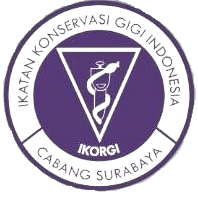EKSPRESI Nuclear Factor of Activated T cells c-1 (NFATc-1) DAN OSTEOKALSIN PADA KERUSAKAN TULANG PERIAPIKAL AKIBAT INDUKSI BAKTERI Enterococcus faecalis
Downloads
Bergenholtz G, Preben HB, Reit C. 2010. Apical Periodontitis in Text Book of Endodontology, 2nd ed. UK. Blackwell Publ Ltd. P 113-27.
Pinheiro ET, Gomes BP, Ferraz CC and Souza EL. 2003. Microorganism from Canals of Root Filled Teeth with Periapical Lessions. Int Endod
J. 36 (1) : 1-11.
Rocas IN, Siquera JF Jr, Aboim MC, Rosado AS. 2004. Denaturing
Gradient Gel Electrophoresis Analysis os Bacterial Communities Associated with Failed Endodontic Treatment. Oral Surg Oral Med Oral Pathol Oral Radiol Endod 98 : 741-49.
Swardfager W, Lanctí´t K, Rothenburg L, Wong A, Cappell J dan Herrmann
N 2010. A Meta-Analysis of Cytokines in Alzheimer's Disease.
Journal Biology Psychiatry 68(10):
–41.
Coon D, Gulati A, Cowan C, He J. 2007. The Role of Cyclooxygenase-2 (COX-2) in Inflammatory Bone Resorption. JOE. 35 (4) : 432-36.
Takayanagi H. 2007. The Role of NFAT in Osteoclast Formation. Ann NY Acad Sci. 116 : 227-37.
Asagiri M, Takayanagi H. 2009. The
MolecularYnderstandingof
Osteoclast Differentiation Bone. 40 :
-64.
Aubin,J.E., Bonnelye E. 2000. Osteoprotegerin and Its Ligand a New Paradigm for Regulation of Osteogenesis and Bone Resorption. Osteoporos Int,11(11) 905-13.
Stashenko et al., 2007. Th1 Immune Response Promotes Severe Bone
ResorptionCausedby
Porphyromonas gingivalis. American Journal of Pathology.170: Pp.203-13.
Abbas, A.K and Litchman, A.H. 2010.
Cellular and Molecular Immunology. 4th ed. Philadelphia: WB Saunders Company. P 235-69.
Lorenzo J, Horowitz M and Choi Y.
Osteoimmunology :
Interactions of The Bone and
Immune System. Endocrine Rev. 29
(4) : 403-40.
Park OJ, Kim J, Yang J, Yun CH, and Han SH.2015. Enterococcus feacalis Inhibits Osteoclast Differentiation and Induces Chemokine Expression. J Endod. Sep;41(9): 1480-5.
Tjan Yaguang. 2013. Effect of Enterococcus faecalis Lipoteichoic Acid on Apoptosis in Human Osteoblast like cells. Journal of endodontic Feb 15 : 761-8.
Wang S, Deng Z, Seneviratne CJ, Cheung GS, Jin L, Zhao B, and Zhang C. 2015. Enterococcus faecalis Promotes Osteoclastogenesis and Semaphorin 4D Expression. Innate Imun. Oct;21(7):726-35.

CDJ by Unair is licensed under a Creative Commons Attribution 4.0 International License.
1. The journal allows the author to hold the copyright of the article without restrictions.
2. The journal allows the author(s) to retain publishing rights without restrictions










